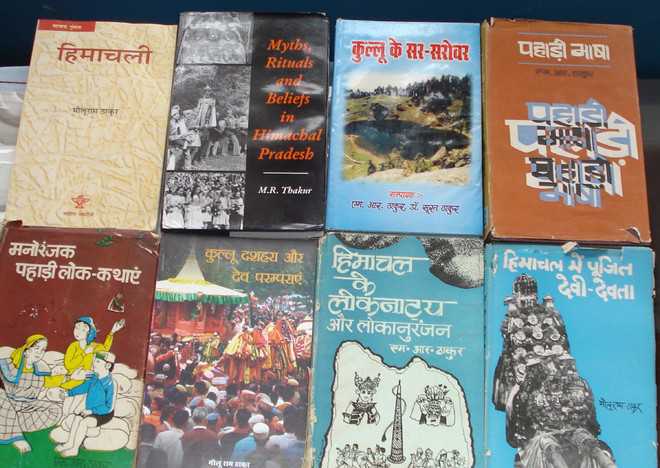Molu Ram — an embodiment of Pahari culture
Shriniwas Joshi
Molu Ram Thakur has rural humility and simplicity. He knows and knows that he knows so has reflected his knowledge in several books (see photo). His forte is Kullu culture though his span covers the cultural aspect of the entire state.
Sometimes you see a pleasant quality in a person or thing that is hard to describe, French call it ‘je ne sais quoi’. When I am writing this piece on Molu Ram, whom I have known since 1984, I have ‘je ne sais quoi’ towards him, so hold my pen with élan in his honour. Molu Ram is an embodiment of Pahari culture and his pen is not tired even today when he is in the 89th year of his life (see photo).
The literary circle accepts him as an eminent folklorist, linguist and a keen observer of the life of hill people. And he truly is a linguist with honours in Hindi and winning gold medals for diplomas in Chinese and Tibetan languages. His body and soul is for Kullu where he was born on the June 18, 1928, in the house of Budh Ram Thakur at Shanghan village in Bhalyani.
He dug out the great linguist Dr Grearson supporting Kulluvi as: (i) Kulluvi and Kyonthali-Baghati (western) are the prominent dialects here; (ii) Mandyali is a form of southern Kulluvi which merges with Kangri and Punjabi; and (iii) Chambyali is that form of Kulluvi which mixes with Dogri of Jammu and Bhadravahi.
Thus, buoyed up by the espousal of Grearson, he believes that the origin of almost all Himachali dialects is in Kulluvi which carries the chief qualities of being a language of the state. Although there are several wise men who believe that with totally diverse dialects there could not be a common Pahari language, yet Molu Ram is a strong proponent of a Pahari language for Himachal. The Sahitya Akademi heard his voice and published his book ‘Himachali’.
Besides Pahari, he writes both in Hindi and English. His book ‘An easy way to Hindi and Hindi Grammar’ was bulk-purchased by the Education Ministry of the Government of India and then he once again wrote ‘Myths, Rituals and Beliefs in Himachal Pradesh’ in English in 1997. He describes a myth that has erupted from the soil of Himachal Pradesh on Moon Eclipse. The father of Moon, once, borrowed money from Rahu.
He could not repay and so handed over his daughter Moon to him against the loan. The Moon preferred to fly to the sky instead of serving as Rahu’s wife. Now whenever Rahu goes to the sky to bring Moon back, she hides herself and the people on the Earth give satnaja (seven kinds of grains) in charity and chant, “Rahu raksaa mhaari Chandra chhor/ Le til, maash, chaul, khor” (O Rahu, save us please and give a boon/ Accept sesame, maash, rice, walnuts and leave the moon.) Full of Pahari anecdotes, it is worth read.
Molu Ram is an authority on Kullu Dasehra. The Kullu Dasehra is celebrated on Dhalpur Ground. Molu Ram says that it was earlier called Thara-Kardu-Ri-Sauh. Rishi Jamadagni went to Kailash once and while returning, he brought a basket made of bamboo, called Kardu, in that Kardu there were 18 idols of various deities. He rested at Chandrakhani Mount when a blizzard flew away the idols from the Kardu; these deities fell at different places or ‘sauh’ at Dhalpur which was then named as Thara-Kardu-Ri Sauh.
He has edited a book “Kullu ke Sar-Sarovar” on wetlands of Kullu and Lahaul and Spiti and the various writers have covered 27wetlands. It has to be informative but the firsthand observation of the wetlands has given it thrill.
His book “Himachal ke Loknatya aur Lokaranjan” published in 1981 is the book that I very often use in my writings and speeches. It covers the total folk theatres of Himachal Pradesh and also explains the theatre as done in the field. Molu Ram has filled the cultural canvas of Himachal with authentic colours and I think that nobody in the coming years will hold a palette to paint the hill culture with such proficiency. May
God give him more fruitful years!
— The writer is a retired bureaucrat









